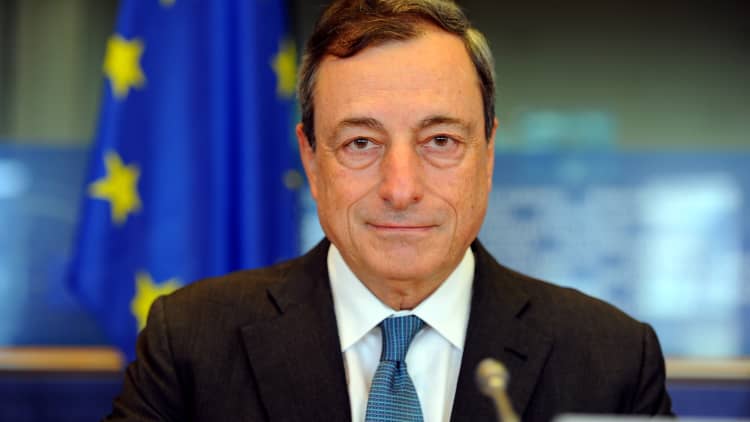
If Mario Draghi wants to have a significant market impact after Thursday's European Central Bank meeting, he better not think small.
The financial world's collective gaze will be focused on the ECB president after the session, during which policymakers are expected to launch a U.S.-style quantitative easing program aimed at injecting liquidity into the sputtering euro zone economy, and goosing asset prices in the process.
History, at least that generated by the Federal Reserve's historically ambitious three rounds of QE, would suggest that the initiative would boost stocks, commodities and bond yields and, hopefully, generate some real economic growth.
However, that's likely dependent upon how aggressive Draghi wants to get with the ECB's version of QE, and specifically whether it can shock a market that already is well aware of the plan.
"Our view is that the extent to which the ECB will surprise markets depends on size (well above market expectation of 500 billion euros) and the extent to which markets will perceive QE as being open-ended," Gilles Moec, European economist at Bank of America Merrill Lynch, wrote in a report for clients. "ECB communication will be the key."

The latter part of the remark refers to the post-meeting news conference Draghi will hold. Indications from him that the ECB continues to plan a "whatever it takes" approach to easing could spark markets, while anything less would be a disappointment.
Read More'Fading' Europe faces QE risks: Italian business
Moec figures the program will entail government bond buying of between 500 billion and 700 billion euros ($580 billion and $810 billion) over the span of 18 months, a close-to-consensus expectation that likely already is priced in.
When headlines leaked of what the ECB was considering, the euro briefly sold, then rebounded and eventually settled slightly higher against the dollar. The trading action was an indication of "how baked-in expectations are to current market prices," said Christopher Vecchio, currency analyst at DailyFX.
That's precisely why Thursday's announcement could just be the first leg of ECB QE, just as the Fed launched two of its own initiatives before finally settling, in the third round, on simply telling the market the asset purchases were "open-ended" and could continue indefinitely. (As it happened, the Fed ended QE3 in October.)
Citigroup economist Willem Buiter thus expects an opening salvo of 600 billion euros over two years, which likely won't sate the appetite of investors wanting a full frontal attack on deflation.
Read MoreIs Draghi about to massivelymisfire?
"We regard such a program as far from optimal: our preference would be for a bigger program, over a shorter period, with full mutualization of any losses agreed at the outset," Buiter said in a note. "But a limited program may well be needed to get wide support."
"Such a program may well achieve the ECB's balance sheet aims but, even with further euro weakness, we doubt it will be enough to break the economy out of 'low-flation.' Hence, ECB QE probably will be scaled up further over time," he added.
In total, QE in Europe, whatever its size, may get more credit than it deserves for what Bespoke Investment Group projects will be a strong year for euro zone equities.
In fact, Bespoke's Paul Hickey argued in an analysis that one of the big contrarian plays for the year will be European stocks outperforming their U.S. counterparts. That's been the trend so far in 2015, and he expects it to continue.
Read MoreHere's how the ECB could deliver a euro shock
"U.S. assets (currency and stocks) are relatively overweighted at present; on the other hand, the EUR is underweighted, suggesting that a reversal of both trades (short Europe, long the U.S.) may be extended and poised to reverse," Hickey said. "This is by no means a perfect signal, but in our view it supports an against-the-herd trade: buying EUR-denominated assets (currency and stocks) to take advantage of a contrarian view that Europe will outperform, regardless of ECB action."
But Peter Boockvar, a Fed critic who believes QE has outlived its usefulness, said the ECB move is likely a last-ditch effort for central banks to help a slowing global economy.
"This is the final chapter of the extraordinary central bank largesse thrown upon the world since 2008," said Boockvar, chief market analyst at The Lindsey Group.
"Stocks and bonds of course have benefited tremendously more but the question is for how much longer now that we are at an important moment in the history of central banking. As QE is just a massive bubble-blowing exercise and is about to see its last hurrah, I expect the ongoing correction occurring in U.S. stocks will continue to roll into more and more as the year progresses."






